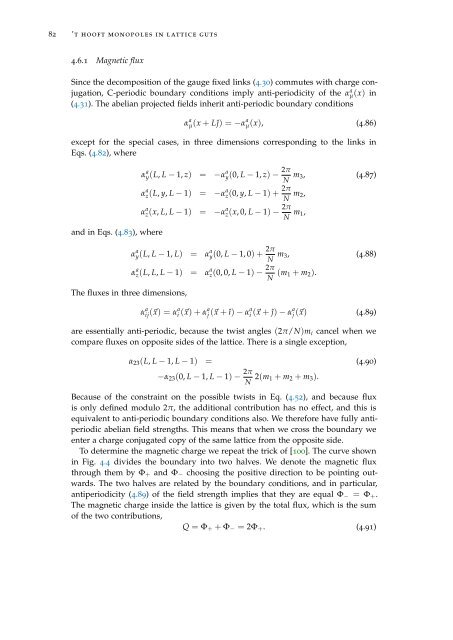Topology, symmetry, and phase transitions in lattice gauge ... - tuprints
Topology, symmetry, and phase transitions in lattice gauge ... - tuprints
Topology, symmetry, and phase transitions in lattice gauge ... - tuprints
Create successful ePaper yourself
Turn your PDF publications into a flip-book with our unique Google optimized e-Paper software.
82 ’t hooft monopoles <strong>in</strong> <strong>lattice</strong> guts<br />
4.6.1 Magnetic flux<br />
S<strong>in</strong>ce the decomposition of the <strong>gauge</strong> fixed l<strong>in</strong>ks (4.30) commutes with charge conjugation,<br />
C-periodic boundary conditions imply anti-periodicity of the α a µ(x) <strong>in</strong><br />
(4.31). The abelian projected fields <strong>in</strong>herit anti-periodic boundary conditions<br />
α a µ(x + Lĵ) = −α a µ(x), (4.86)<br />
except for the special cases, <strong>in</strong> three dimensions correspond<strong>in</strong>g to the l<strong>in</strong>ks <strong>in</strong><br />
Eqs. (4.82), where<br />
<strong>and</strong> <strong>in</strong> Eqs. (4.83), where<br />
The fluxes <strong>in</strong> three dimensions,<br />
α a y(L, L − 1, z) = −α a y(0, L − 1, z) − 2π N m 3, (4.87)<br />
α a z(L, y, L − 1) = −α a z(0, y, L − 1) + 2π N m 2,<br />
α a z(x, L, L − 1) = −α a z(x, 0, L − 1) − 2π N m 1,<br />
α a y(L, L − 1, L) = α a y(0, L − 1, 0) + 2π N m 3, (4.88)<br />
α a z(L, L, L − 1) = α a z(0, 0, L − 1) − 2π N (m 1 + m 2 ).<br />
αij a (⃗x) = αa i (⃗x) + αa j (⃗x + î) − αa i (⃗x + ĵ) − αa j (⃗x) (4.89)<br />
are essentially anti-periodic, because the twist angles (2π/N)m i cancel when we<br />
compare fluxes on opposite sides of the <strong>lattice</strong>. There is a s<strong>in</strong>gle exception,<br />
α 23 (L, L − 1, L − 1) = (4.90)<br />
−α 23 (0, L − 1, L − 1) − 2π N 2(m 1 + m 2 + m 3 ).<br />
Because of the constra<strong>in</strong>t on the possible twists <strong>in</strong> Eq. (4.52), <strong>and</strong> because flux<br />
is only def<strong>in</strong>ed modulo 2π, the additional contribution has no effect, <strong>and</strong> this is<br />
equivalent to anti-periodic boundary conditions also. We therefore have fully antiperiodic<br />
abelian field strengths. This means that when we cross the boundary we<br />
enter a charge conjugated copy of the same <strong>lattice</strong> from the opposite side.<br />
To determ<strong>in</strong>e the magnetic charge we repeat the trick of [100]. The curve shown<br />
<strong>in</strong> Fig. 4.4 divides the boundary <strong>in</strong>to two halves. We denote the magnetic flux<br />
through them by Φ + <strong>and</strong> Φ − choos<strong>in</strong>g the positive direction to be po<strong>in</strong>t<strong>in</strong>g outwards.<br />
The two halves are related by the boundary conditions, <strong>and</strong> <strong>in</strong> particular,<br />
antiperiodicity (4.89) of the field strength implies that they are equal Φ − = Φ + .<br />
The magnetic charge <strong>in</strong>side the <strong>lattice</strong> is given by the total flux, which is the sum<br />
of the two contributions,<br />
Q = Φ + + Φ − = 2Φ + . (4.91)
















